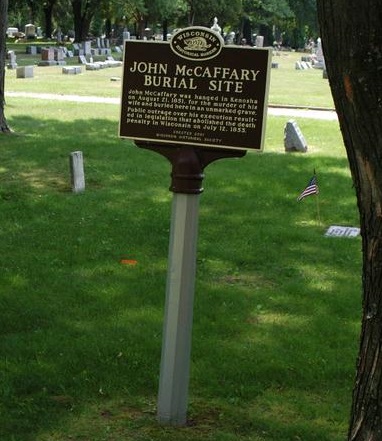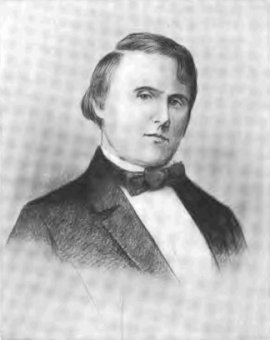On this date in 1851, Ruben Dunbar hanged in New York for murdering two little boys: the 8- and 10-year-old nephews to his widowed mother’s second husband. Thanks to the mother’s remarriage, these boys had supplanted Dunbar as the heirs to his mother’s property.
We’re indebted for highlighting this case to our crime-blogging friends at Murder by Gaslight, who also call attention to a short pamphlet entitled “Phrenological Character of Reuben Dunbar, With a Short Treatise on The Casuses and Prevention of Crime”. This item is available free from Google Books and contains the findings of a phrenologist — Margaret Thompson — who examined Dunbar. (Phrenology was already into an advanced stage of disrepute by the 1850s.)
We begin with the core metrics:
His physiology is sound and good. He has a fair proportion of all the temperaments, with a predominance of the vital. The size of his head is 22 3/4 inches in curcumference, over the organs of Individuality and Philoprogenitiveness; and 13½ inches over the top, from Destructiveness to Destructiveness, over Firmness. The size of his phrenological developments, on a scale of from one to seven, are as follows:
Amativeness, 5; Philoprogenitiveness, 4; Adhesiveness, 6; Inhabitiveness, 5; Concentrativeness, 4; Vitativeness, 6; Combativeness, 6; Destructiveness, 6; Alimentiveness, 6; Acquisitiveness, 6; Secretiveness, 7; Cautiousness, 6 to 7; Approbativeness, 7; Self-Esteem, 4; Firmness, 7; Consceintiousness, 4; Hope[,[ 5; Marvellousness, 4; Veneration, 4; Benevolence, 5; Constructiveness, 5; Ideality, 4; Sublimity, 5; Imitation, 5; Mirthfulness, 5; Individuality, 6; Form, 6; Size, 6; Weight, 6; Color, 6; Order, 6; Calculation, 5; Locality, 6; Eventuality, 6; Time, 5; Language, 5; Causality, 5; Comparison, 6
Several pages then elucidate the weight and combination of these figures in the estimation of the examiner, also neatly retrofitting the crime that she knows Dunbar stands accused of.
Philoprogenitiveness is only average. He might love his own children, but would not care for the children of others; and his large Destructiveness and Combativeness would incline him naturally to be impatient, severe, and even cruel with children over whom he has control.
His selfish propensities are large, while his moral faculties are between full and average. In such an organization the selfish feelings have a very powerful influence, and without great care and constant exercise of the moral organs, will be sure to gain the ascendancy. Acquisitiveness is large and very active. This gives him a strong desire to obtain money, property, &c.; and with his inferior moral brain, would lead him to be penurious and covetous. Secretiveness is very large. He is exceedingly cunning, and capable of acting artfully and deceitfully; has uncommon power to conceal his real feelings. Seldom discloses his plans to others; is secretive and says little. Destructiveness and Combativeness are large also; so is firmness. These, with his other combination of organs, make him quarrelsome, harsh, severe, self-willed, tenacious of his rights, wilful, and desperately determined.
All told, she reckons, Dunbar labored under “an unfortunate organization; one in which the animal propensities govern, because the moral faculties are not sufficiently large to balance and control them.”
Thompson’s pamphlet then pivots curiously from her diagnosis of Dunbar to that of his entire society, and reaches her own science’s strange circuits a familiar conclusion:
Crime is caused by an abuse or perverted action of the animal propensities, owing principally to education, and partly to the hereditary transmission of those faculties from parents to their children … It is a fact which comes within the range of our observation daily, that the faculties of Destructiveness and Combativeness are almost universally strengthened and encouraged in children by severe and coercive measures … Punishment with the rod invariably tends to give a highly stimulated and perverted action to Destructiveness and Combativeness … by repeated whippings an increased quantity of blood is sent to the base of the brain, and it is thereby inflamed and excited, and increased in size and activity. If children are punished in anger, and from a spirit of retaliation, we may reasonably expect to see in them, when full grown and matured, an abnormal exercise of Destructiveness and Combativeness.
Thompson recommends a more rehabilitative approach to criminal justice, a combination of instruction and what she calls “the law of love” — “of the efficacy and power of kindness over man, even when in ruins, and sunk to the lowest depths of sin and degradation. However far he may have wandered from the paths of truth and virtue, still he is a man and a brother — an immortal being, having claims on our sympathy, and our best efforts to reform him and make him happy.”
On this day..
- 1964: Nguyen Van Nhung, Diem executioner
- 1821: Henry Tobin, extortionist
- 1731: Alejo Calatayud, Mestizo
- 1550: Four Anabaptist martyrs at Lier
- 1679: Robert Foulkes, adulterous minister
- 1902: A day in the death penalty around the Pacific Northwest
- 1923: Eligiusz Niewiadomski, assassin-artist
- 1632: Aris Kindt, Rembrandt subject
- 1879: Takahashi Oden, dokufu and she-demon
- 1955: Moshe Marzouk and Shmuel Azar
- 1945: Private Eddie Slovik, the last American shot for desertion
- 1606: Guy Fawkes and other Gunpowder Plot conspirators




 This well-bred** Kentuckian veteran of the Mexican-American War ditched a New Orleans customs-house gig when
This well-bred** Kentuckian veteran of the Mexican-American War ditched a New Orleans customs-house gig when